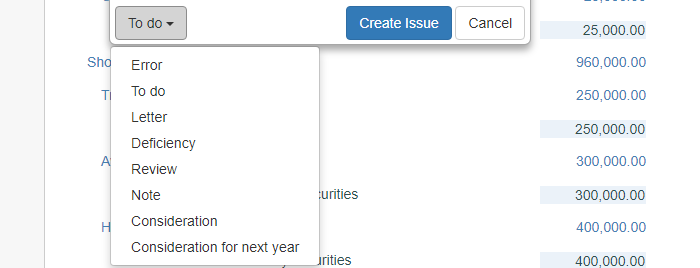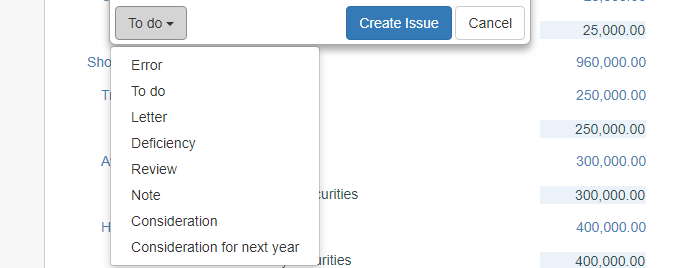Add and complete review notes (issues)
In engagements, you can add and complete review notes. Review notes can signal to the engagement team that additional work is required on a document or that specific tasks must be completed for an engagement.
Add review notes (issues)
Review notes can be added to an engagement workspace (entity) or to documents, checklists and other engagement artifacts in an engagement file (online and desktop).
Best Practice: It's better to create a review note (issue) from within the engagement file so that your team can have context as to which document, checklist, line or engagement requires attention. For general review notes, consider using the tasks feature in the engagement workspace.
Document issues in the engagement file
You can add issues to a specific document, a specific item in a document or globally (for the entire engagement).
To add a global issue for the entire engagement:
-
From the top menu, select the Add Issue icon (
 ).
).A pop-up displays on the page showing a text box with a formatting toolbar.
-
Enter a description for your issue in the text box.
If you want to tag other staff members to view the issue, you can enter the @ symbol and then select their name from the list. You can also select any contact who has access to the engagement.
-
Select an issue type from the drop-down menu at the bottom of the editor.

-
Select Create Issues.
The Issues icon (
 ) is also available at most items in engagement documents. You can follow the same steps to record issues at a specific document item. For example, a procedure in a checklist.
) is also available at most items in engagement documents. You can follow the same steps to record issues at a specific document item. For example, a procedure in a checklist.
To add an issue in a document item:
-
Open a document in your engagement and select the item that you want to record an issue for.
In this example, we are adding an issue in a trial balance line.
-
Select the Issues icon (
 ).
).A pop-up displays on the page showing a text box with a formatting toolbar.
-
Enter a description for your issue in the text box.
If you want to tag other staff members to view the issue, you can enter the @ symbol and then select their name from the list. You can also select any contact who has access to the engagement.
-
Select an issue type from the drop-down menu at the bottom of the editor.

-
Select Create Issue.
View a summary of issues
All issues that are outstanding, resolved or cleared are accessible on the Issues report. You can use this report to determine what issues currently require review, or to view the history of review on a document.
Note: It is recommended to clear an issue if you want to retain the history of the issue. If you delete an issue, it is removed from the engagement file and the Issues report.
To view a summary report of issues and review notes:
From the top menu, select Issues. The Issues report is displayed.
The report displays the following information for each issue in your current engagement:
-
Issue type
-
Description of the issue
-
Replies from engagement team members
-
Status changes
-
Current status
At the top of the report, issues are summarized by type. You can use the drop-down menus to filter the report by issue type and status.
The record of current and historical review notes is displayed. You can change the status of outstanding issues (Resolve, Clear, Delete) or edit them in this view.
Complete review notes (issues)
When completing review notes you may be required to collaborate with other staff and client contacts. Whether you're assigned a review note from an engagement file or the engagement workspace, you can easily ping and tag other people on the item to get clarification or additional client information.
Once complete, mark the task as completed or the issue as resolved. In an engagement file you also have the option to clear the issue, thereby removing the notice while maintaining the note itself.
Best Practice: It's better to create a review note (issue) from within the engagement file so that your team can have context as to which document, checklist, line or engagement requires attention. For general review notes, consider using the tasks feature in the engagement workspace.
Complete issues in an engagement file
When you're assigned an issue, you will be assigned to a specific document, document item or engagement.
Once an issue is addressed, mark it as Resolved. You can also clear the issue after it is resolved or if the issue is not longer required.
Resolve issues
After completing your review, you can resolve the issue. You can resolve the issue from the Issue menu or from the associated document. Resolving the issue removes the notification on the issues icon, while maintaining the history of the issue in the engagement file.
To resolve an issue:
-
Select the Issues icon (
 ).
).A popup displays next to the icon showing the details of the issue.
Note: If there is more than one issue, left and right arrows (
 ) are available on the pop-up. Select the arrows to scroll through the issues.
) are available on the pop-up. Select the arrows to scroll through the issues. -
Select Resolve.
Clear issues
After resolving an issue, or if the issue is no longer required, you can clear it from the issues menu. Clearing the issue removes the notification on the issues icon, while maintaining the history of the issue in the engagement file.
To clear a review note:
-
Select the Issues icon (
 ).
).A pop-up displays next to the icon showing the interaction log for the resolved note.
Note: If there is more than one resolved note, left an right arrows (
 ) are available on the pop-up. Select the arrows to scroll through the resolved notes.
) are available on the pop-up. Select the arrows to scroll through the resolved notes. -
Select Clear.
Delete issues
You can delete issues that are no longer relevant to the engagement. Note that you can only delete an issue you've created. Only an Admin user can delete issues created by other users.
To learn more, see Built-in roles.
To delete an issue:
-
Select the Issue icon (
 ).
).A pop up with the issue details displays.
-
Select the Delete icon (
 ).
).A confirmation message displays.
-
Select Yes to delete the issue.
Once you've deleted an issue, it is automatically removed from the engagement history and the Issues page.
